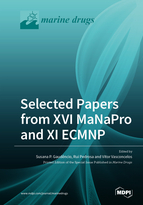Selected Papers from XVI MaNaPro and XI ECMNP
A special issue of Marine Drugs (ISSN 1660-3397).
Deadline for manuscript submissions: closed (30 September 2020) | Viewed by 65004
Special Issue Editors
Interests: marine natural products; structure elucidation; secondary metabolites; blue biotechnology; bioactive compounds from actinomycetes; drug discovery and biotechnological applications
Special Issues, Collections and Topics in MDPI journals
Interests: marine biotechnology; marine drug discovery; cellular pharmacology and cellular biology
2. CIIMAR, Interdisciplinary Centre of Marine and Environmental Research of the University of Porto, 4450-208 Porto, Portugal
Interests: cyanobacteria; toxins; cyanotoxins; marine biotechnology; secondary metabolites; cyanobacterial blooms; ecotoxicology; environmental contamination
Special Issues, Collections and Topics in MDPI journals
Special Issue Information
Dear Colleagues,
On behalf of the Organizing Committee for the XVI MaNaPro and XI ECMNP, we would like to cordially invite you to the ‘must-attend’ conference of 2019: the XVI International Symposium on Marine Natural Products and XV European Congress on Marine Natural Products joint meeting, http://wmnp2019.ipleiria.pt/, to be held in Peniche, Portugal, from September 1st to 5th, 2019.
Young scientists in the marine natural products (MNP) field from all over the world are especially encouraged to participate. Senior experts, rising MNP stars and early scientists will present their results in a combination of plenary lectures, contributed oral communications, and poster sessions.
The joint XVI MaNaPro and XI ECMNP meeting includes the following topics:
- Isolation and structure elucidation of marine natural products;
- Biosynthesis and chemical synthesis of marine natural products;
- Marine chemical ecology and ecosystem functioning;
- Marine natural products in chemical biology and biotechnology;
- Drug discovery and development.
To maximize the impact of this conference to the marine natural products community, the chairs of this conference are organizing a Special Issue of Marine Drugs dedicated to this symposium entitled “Selected Papers from the XVI MaNaPro and XI ECMNP”. We kindly invite the attendees to contribute manuscripts for research papers or reviews for this Special Issue of Marine Drugs.
* Each submission will enjoy a 20% discount on APC, after accepted.
Dr. Susana P. Gaudencio
Prof. Dr. Rui Pedrosa
Prof. Dr. Vitor Vasconcelos
Guest Editors
Manuscript Submission Information
Manuscripts should be submitted online at www.mdpi.com by registering and logging in to this website. Once you are registered, click here to go to the submission form. Manuscripts can be submitted until the deadline. All submissions that pass pre-check are peer-reviewed. Accepted papers will be published continuously in the journal (as soon as accepted) and will be listed together on the special issue website. Research articles, review articles as well as short communications are invited. For planned papers, a title and short abstract (about 100 words) can be sent to the Editorial Office for announcement on this website.
Submitted manuscripts should not have been published previously, nor be under consideration for publication elsewhere (except conference proceedings papers). All manuscripts are thoroughly refereed through a single-blind peer-review process. A guide for authors and other relevant information for submission of manuscripts is available on the Instructions for Authors page. Marine Drugs is an international peer-reviewed open access monthly journal published by MDPI.
Please visit the Instructions for Authors page before submitting a manuscript. The Article Processing Charge (APC) for publication in this open access journal is 2900 CHF (Swiss Francs). Submitted papers should be well formatted and use good English. Authors may use MDPI's English editing service prior to publication or during author revisions.









